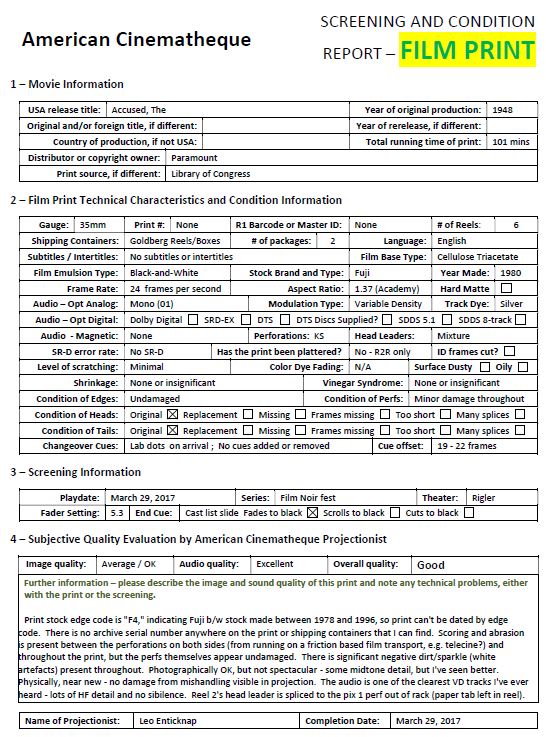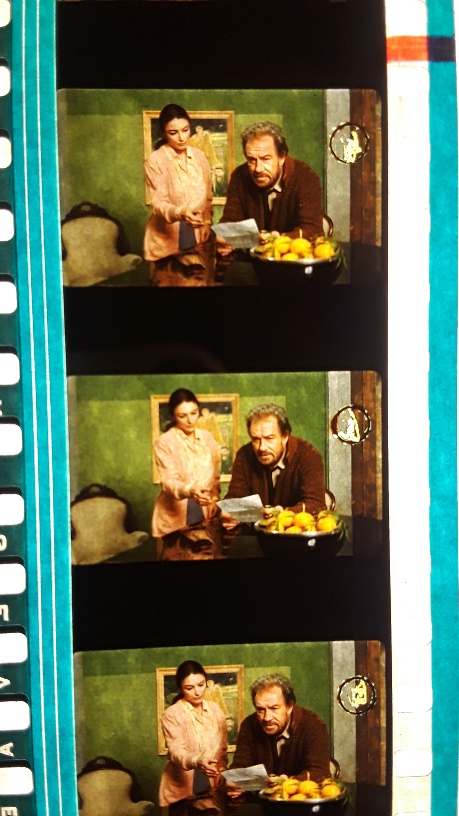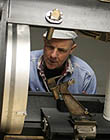|
|
 
|
|
Author
|
Topic: "Enhanced" Cue Mark Rant
|
|
|
|
|
|
|
|
|
|
|
|
|
Leo Enticknap
Film God

Posts: 7474
From: Loma Linda, CA
Registered: Jul 2000
|
 posted 04-05-2019 09:54 PM
posted 04-05-2019 09:54 PM





Dealing with the big nonprofit, FIAF archives can be very problematic. The core of the problem is that very few of their technicians and access officers have any projection experience, and therefore dispatch their prints to theaters in a form that makes them difficult to handle and prepare for presentation efficiently; and also impose sometimes unrealistic and unnecessary rules on projectionists.
I once witnessed a screaming row between an A-list movie maker and the director of one of the world's most prestigious archives in my booth. The cause of the disagreement was that the filmmaker was insisting that the print of his restored movie be built up and run from a platter, because in his experience, the color temperature of the light from two projectors in a changeover pair was never identical, and he found the shift at each changeover highly distracting.
The archivist was taking the predictable "You cut the heads and tails off my precious print and I'll personally see to it that you are escorted to a cellar and introduced to The Gimp" line.
The filmmaker clearly had significant knowledge of projection. In comments to me before the archivist arrived, he identified various pieces of equipment in the booth and commented on them intelligently. The archivist clearly (from his remarks and comments) had next to none.
Prints arriving from these institutions with evidence of mishandling by incompetents is frequent. I suspect the reason to be that these archives simply don't have the staff resources to do a detailed bench examination of every print that comes back from a booking, and probably just look at a random sample. The problem happens when damage caused by venue A is not caught, the print goes to venue B, venue B's projectionist thinks that the damage is typical wear and tear for a print of that age and provenance, does not report or make a fuss about it, the print is examined on return from venue B, and venue B gets whacked with a bill for a new print. I've seen this happen many times.
So the moral of the story is, document and report up the wazoo. I always had a rule with prints from the big studio and non-profit archives, which was to grade the print overall one classification lower than I would any other.
So for a regular print that I would grade as excellent, if it was an archival one I would check good; average rather than good, poor rather than average, and bad rather than poor. I would also make detailed, copious notes of defects that I wouldn't bother to document in any other print. If there was any damage that I thought would be picked up by the archive on return, I would have a co-worker look at the print with me, so that I had a witness that the print arrived with the defect.
For example, here's a typical archive print report of the sort I used to do:

The slight scuffs between the perfs (very likely from having been run on a badly tensioned continuous motion telecine or scanner, with dirty rollers) is not something that I'd have bothered to note if this were a commercial rep print. But in this case, the need exists to protect oneself against a "You broke it, you own it" accusation.
| IP: Logged
|
|
|
|
|
|
|
|
Leo Enticknap
Film God

Posts: 7474
From: Loma Linda, CA
Registered: Jul 2000
|
 posted 04-06-2019 11:06 PM
posted 04-06-2019 11:06 PM





+1 to click strips as an alternative to visible cue marks if an archival print arrives without any cues on the print whatsoever. When film was in mainstream use, the French labs tended not to put cue marks on their prints at all (presumably in the expectation that most of them would be plattered), and so if I got an Eclair or an LTC print that was new and I was running it in a changeover house, I'd put click strips on it. More recently, some European archives seem to have carried on this tradition (the Nederlands Filmmuseum especially, which seemed to have a policy both of not putting cue dots on their prints, and banning projectionists from plattering them!): I got a few when I was at the Egyptian.
Some booths make using click strips easier than others, the model of projector and the ambient noise level in the booth being the main factors. For a projectionist trying them for the first time, I'd suggest making up quite a long loop of scrap film and running it for a few minutes to familiarize yourself with the sound of the splicing tape going through. In many booths you only need a strip on the base side, but if it's too quiet you can tape both sides. You'll also need a footage and frame counter, and I'd suggest putting a cheat sheet on the bench, so that the correct positioning of the strips is always to hand.
By gently removing the tape using gloves and pushing one corner of the strip with a Dolby screwdriver to get it started, the click strips can be removed without anyone ever knowing that they were there.
| IP: Logged
|
|
|
|
All times are Central (GMT -6:00)
|
|
Powered by Infopop Corporation
UBB.classicTM
6.3.1.2
The Film-Tech Forums are designed for various members related to the cinema industry to express their opinions, viewpoints and testimonials on various products, services and events based upon speculation, personal knowledge and factual information through use, therefore all views represented here allow no liability upon the publishers of this web site and the owners of said views assume no liability for any ill will resulting from these postings. The posts made here are for educational as well as entertainment purposes and as such anyone viewing this portion of the website must accept these views as statements of the author of that opinion
and agrees to release the authors from any and all liability.
|

 Home
Home
 Products
Products
 Store
Store
 Forum
Forum
 Warehouse
Warehouse
 Contact Us
Contact Us




 Printer-friendly view of this topic
Printer-friendly view of this topic





![[Embarrassed]](redface.gif)




![[eyes]](graemlins/eyes.gif)
![[evil]](graemlins/evil.gif)
![[Mad]](mad.gif)
![[puke]](graemlins/puke.gif)

![[Razz]](tongue.gif)





